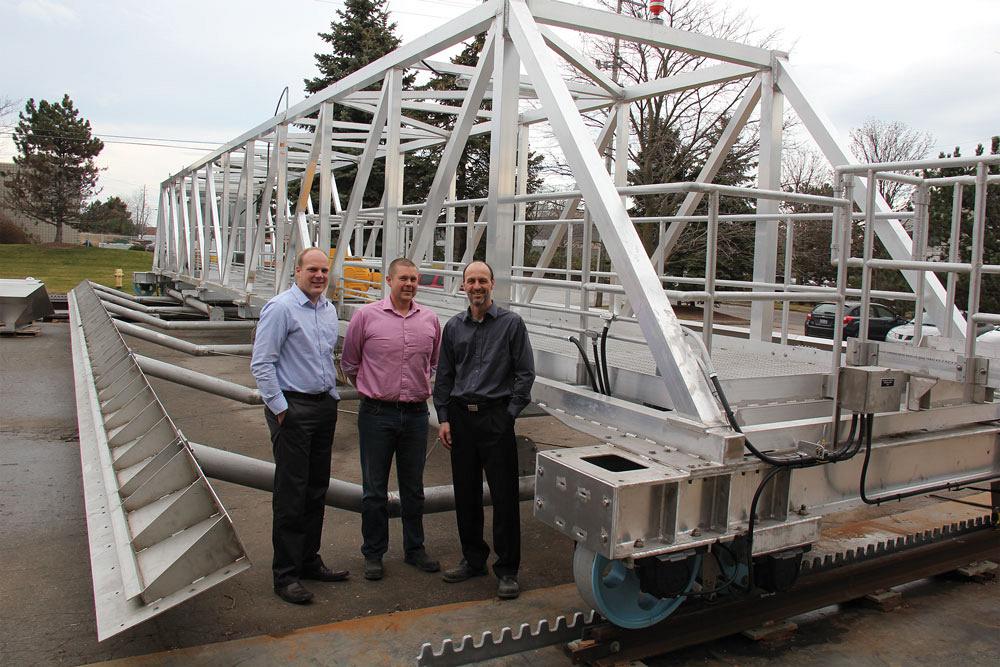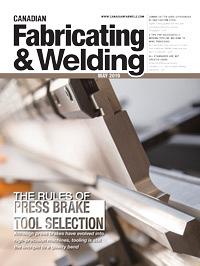Editor
- FMA
- The Fabricator
- FABTECH
- Canadian Metalworking
Combo cutter adds efficiencies at D&R Custom Steel
Higher cutting speeds and less post-processing help shop improve throughput
- By Rob Colman
- May 13, 2019
- Article
- Fabricating

These drum filters are good examples of the stainless steel jobs that D&R Custom Steel have become known for over the years.
Over the course of almost 50 years, D&R Custom Steel’s fabrication expertise has served a variety of industries, from water and air treatment applications to mining and material handling. The Pickering, Ont.-based shop has come to focus on jobs primarily involving stainless steel and aluminum, though it also works with carbon steel and specialty or exotic metal alloys.
The company has always kept an eye out for both process and equipment improvements that could make a difference to its bottom line while preparing it for many more years of success. The most recent such investment is a combination plasma/fibre laser cutting table.
Next Steps in Mind
D&R was founded in 1971 by Dutch immigrants John DeWit and Yke Reitsma, and it continues to be a family-run affair. Reitsma’s grandson Chris Boers, now production manager, shares in the ownership with President and Sales Manager Dan Engelage and Project Manager Andre Haaksma.
The company is constantly thinking about where the bottlenecks are in its processes, and once one bottleneck is addressed, management moves on to the next. When Canadian Fabricating & Welding last visited D&R, it had recently introduced trackless welding carriages to automate the welding of digester covers. That investment saved the company countless man-hours. It now uses two trackless carriages and one track-based system purchased specifically for a larger project.
D&R is equipped for most fabrication needs. In the past half-dozen years or so it has added a new plate roll and profile roll as part of a production cell; a 440-ton, full CNC, 14-ft. press brake; and pulse gas metal arc welding equipment for stainless steel. The shop will soon take delivery of a new forklift truck as well.
None of these investments were made lightly, of course. All were important to the core operations of the company, adding speed, quality, and safety benefits. For instance, having the plate roll and profile roll in one cell meant parts no longer had to be moved manually between two processes, which removed a potential safety hazard.
And the team is always thinking about what step to take next.
“For instance, we evaluated the purchase of a large robotic welding cell, but the capital cost was much greater than the return on investment we calculated on it,” said Chris Boers. “We are still looking at the possibility of adding a small robotic cell for repeat parts or large-volume parts orders, but we are not there yet. But it’s important to us that we continue to evaluate all these options as technologies advance and the cost-benefit on each improves.”
Combo Cutting
As suggested by Boers’ comment, timing on an investment is key for D&R. The return must be there based on the bottlenecks in the shop.
The one gap in the company’s fabrication arsenal until recently was a fibre laser cutting table. Before they made that investment, outsourcing laser cutting work just made more sense.
Several years ago the company refurbished its high-definition plasma table. At the time that increased cutting speeds by about 30 per cent. With the plasma machine on the shop floor, adding a separate laser didn’t make a lot of sense – it would have required another operator, and it would have taken up precious space on the shop floor that, with its already tight space constraints, D&R could not afford.
Instead, the company did all its own nesting of stainless steel sheet and plate at its offices and then paid its supplier to cut it for them.
“At the time, getting our supplier to cut our stainless steel for us cost less than it would have for us to process it ourselves,” said Dan Engelage. “If we had cut that material with our plasma table, we would then have had to grind all the edges, manually drill the holes, and we’d have contamination concerns already because of the use of plasma.”
Two things have changed in the past few years. First, D&R came to focus almost exclusively on aluminum and stainless steel work.
“Cutting carbon steel jobs just doesn’t offer the return that it once did,” said Andre Haaksma. “There are too many job shops that will do that work for a price that just keeps their doors open. We pretty much only cut carbon steel for specific fab jobs of which it is one small component.”
D&R’s concentration on water and air treatment fabrication jobs, as well as related custom work, gave it a definite advantage in moving laser cutting in-house.
The second thing that changed was that the company was able to purchase a combination fibre/plasma cutting table, which meant that all cutting could be managed in one space and managed by one operator.
The machine is an 8-ft. by 20-ft. Messer MetalMaster Xcel combo table equipped with an 8-kW IPG fibre laser and a Hypertherm XPR300™ high-definition plasma system.

D&R’s latest shop acquisition is an 8-ft. by 20-ft. Messer MetalMaster Xcel combo table equipped with an 8-kW IPG fibre laser and a Hypertherm XPR300™ high-definition plasma system.
“Originally we’d planned to purchase a 6-kW laser but were encouraged to go with the 8 kW,” said Engelage. “Using the 8 kW, the cutting speed on 3/16-in., ¼-in., and 3/8-in. stainless – our volume thicknesses – significantly improves. We can cut thicker stainless steel with the laser – up to 1 in. – but you get a lot of striations on the edge that require more work in post-processing, so the plasma still does a better job on that.”
The D&R team has been impressed with the gains they’ve seen by using the table.
“It was definitely the right decision,” said Boers. “We looked at what we were spending on outsourced cutting in the past few years, and on the low end we will see a payback in three to four years.”
The only challenge the team has had with the table is that it doesn’t operate as seamlessly as they would have hoped.
“Many companies using CNC cutting tables produce large-volume parts and cut the same program repeatedly. As a contract fabricator, we rarely cut the same program twice and often ask the machine to cut material in a way not encountered by the equipment supplier,” said Engelage. “As a result, we have challenged Messer to provide solutions that are unique to the way we run our business and how we process our material. This has taken more time to work through than originally anticipated, but we are happy with the results.”
D&R runs two shifts on the combo table, with one person operating the controls and one person loading and unloading the table.
“The machine has two shuttle beds, so we can load and unload while it’s running parts,” said Engelage. “We have two people on the machine because, realistically, the operator can’t leave the screen when a program is running because if you blow a tip or something else happens, you can end up scrapping an expensive plate of stainless, and every piece of material is different. There are any number of faults in a plate that could cause such a problem.”
Despite any limitations in the machine, it still saves time and money for the shop at various stages of production. Bringing all cutting in-house saves production costs and eliminates any supplier lead time concerns. Because D&R already had an operator for its previous plasma system, it had to add only one operator for the night shift. In addition, with the more advanced cutting capabilities of both the laser and a new-generation plasma head, there has been a reduction in post-processing on materials coming off the table.
Preparing for the Future
By late February D&R already had more than half of its capacity booked for the year and a significant amount of work scheduled for 2020. The team is always looking to the future, both in terms of production goals and staffing goals.

To save space on the shop floor, D&R installed a mezzanine above the machine for the laser and plasma systems.
“We have around 60 employees on our team,” said Haaksma. “We had three seasoned employees retire at Christmas, which we are working to replace. That is going to happen through apprenticeships and training. It is hard to hire a seasoned, skilled tradesperson off the street, so we have prepared to build up our capabilities from within.”
D&R is proactive about its recruitment efforts. When we last spoke to the team four years ago, they had nine apprentices registered with the Ministry of Training, Colleges & Universities. That number has gone up since then to 10. The shop is constantly training people to ensure it grows talent for the shop’s future.
At the same time, it is also constantly rethinking how the shop floor will run. For instance, with the new fibre/plasma combo now up and running, the team is making stackable steel skids to manage material movement better to and from the cutting table.
“In our industry, it is all about throughput,” said Engelage. “Ensuring efficient and smooth flow of materials by utilizing the right mix of staffing and equipment enables us to maximize the amount of product we can produce and ship. Maintaining this flow is critical to producing a quality product on time and at a competitive price.”
And it’s thinking through how this movement is going to happen as a team that Engelage sees as a distinct advantage.
“We constantly look for feedback from our entire team to ensure we’re catching where savings in both time and money can be made,” said Engelage. “This has helped us to continually improve throughput while our staff numbers have remained at the same level.”
Editor Robert Colman can be reached at rcolman@canadianfabweld.com.
D&R Custom Steel, www.drsteelfab.com
About the Author

Rob Colman
1154 Warden Avenue
Toronto, M1R 0A1 Canada
905-235-0471
Robert Colman has worked as a writer and editor for more than 25 years, covering the needs of a variety of trades. He has been dedicated to the metalworking industry for the past 13 years, serving as editor for Metalworking Production & Purchasing (MP&P) and, since January 2016, the editor of Canadian Fabricating & Welding. He graduated with a B.A. degree from McGill University and a Master’s degree from UBC.
subscribe now


Keep up to date with the latest news, events, and technology for all things metal from our pair of monthly magazines written specifically for Canadian manufacturers!
Start Your Free Subscription- Industry Events
MME Saskatoon
- May 28, 2024
- Saskatoon, SK Canada
CME's Health & Safety Symposium for Manufacturers
- May 29, 2024
- Mississauga, ON Canada
DiPaolo Machine Tools Open House 2024
- June 4 - 5, 2024
- Mississauga, ON Canada
FABTECH Canada
- June 11 - 13, 2024
- Toronto, ON Canada
Zoller Open House & Technology Days 2024
- June 12 - 13, 2024
- Ann Arbor, MI






















